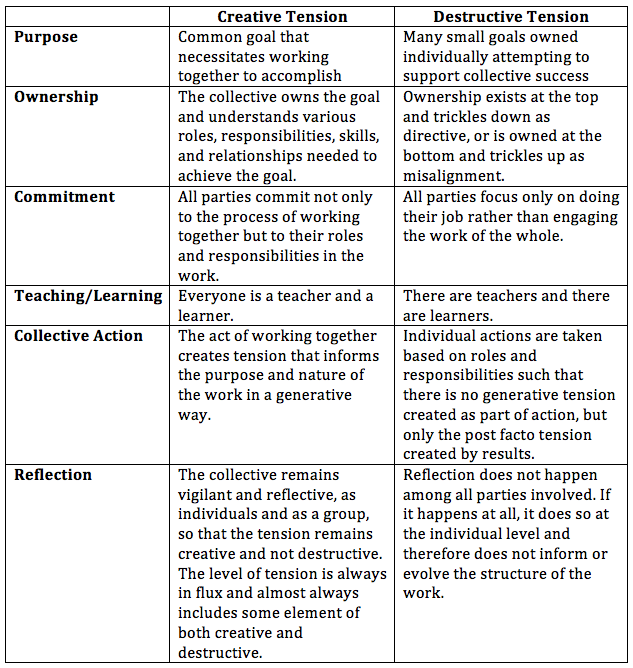|
The problem with public education is that there isn’t enough tension. The other problem with public education is that there’s too much tension. And, perhaps the biggest problem is that both of these are correct; and we don’t distinguish between creative tension and destructive tension. Without distinguishing between the two, we cannot intentionally build structures and relationships that create the systems our students need: systems of shared leadership, strategic risk-taking, and mutual responsibility. Systems of creative tension. Instead, we more commonly build top-down structures that generate destructive tension and bottom-up structures to avoid, relieve, or push back against them. At all levels and relationships, public education is replete with destructive tension. Whether it’s the policymaker focusing on test scores he has no control over, the School Board trying to improve classroom practice it has no experience with, or the district administrator trying to empower principals who have systematically been disempowered, we lack the structures and processes to support creative tension. So, our tension becomes destructive, structural stress, which becomes a self-fulfilling and redundant system of production. So, what are the key differences between a structure that produces destructive tension and one that generates creative tension? The following shows two possibilities for some relatively simply planning among school faculty to improve student outcomes. While this just illustrates the start of planning, the same models and considerations can be extended through all stages of action, reflection, assessment, and improvement.
Making a Plan: The Destructive Tension Approach A principal is approached by a group of teachers who are concerned about increased expectations to provide interventions and supports for students with intellectual disabilities, but without any additional planning time for new strategies. The principal listened to their concerns and then explained the rationale he used when making this decision. He assured them it was the right decision for their school. The principal recommended that the teachers use their current individual prep time to collaborate with other staff and develop individualized plans to meet students' needs. He asked to see their plans at the next staff meeting. Making a Plan: The Creative Tension Approach A principal is approached by a group of teachers who are concerned about increased expectations to provide interventions and supports for students with intellectual disabilities without additional time to develop and plan for the new strategies. The principal adds this topic to the agenda of a staff meeting scheduled for the next week. In that meeting, he asks staff to consider what each is doing in their classroom to ensure all learners have equitable access to instruction in meeting their individual needs. (Reflection) Through the discussion, the staff begins to recognize that too many learners are not finding success and that staff as a whole uses a fairly narrow range of interventions. (Ownership) Together with the principal, they agree on a shared goal to adopt a wider variety of interventions and supports to increase student success and identify the ones they want to focus on first. (Purpose) As part of this, they make a plan to have fellow teachers who are experts in the priority areas provide brief peer-to-peer professional development opportunities during each staff meeting. Over time, they aspire to have each teacher share their successes and challenges with the group. (Commitment, Teaching/Learning) The principal and staff develop a plan to allocate time for teachers to plan for implementation and engage a teacher coach to provide modeling and time to practice and refine their skills. (Collective Action) The principal and staff schedule regular, frequent opportunities to reflect and refine practice individually, with the coach, and in professional learning communities. (Reflection) To reduce the destructive tension that often undercuts efforts to improve how our schools function, intentional practices that nurture creative tension need to be imbedded throughout the relationships within the school and across a school system. Note: These relationships include not only adults, but also the young people as the largest stakeholder in public education. In their absence as a constituent in the variables of the creative tension model, we will never build structurally creative systems. Keep an eye out for our next blog to focus on creative tension among young people and adults. Written by: Anderson Williams, Teri Dary, and Terry Pickeral originally published by the Learning First Alliance
0 Comments
Leave a Reply. |
Categories
All
Archives
April 2024
|

 RSS Feed
RSS Feed